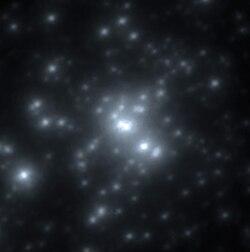R136b
Appearance
| Observation data EpochJ2000.0EquinoxJ2000.0(ICRS) | |
|---|---|
| Constellation | Dorado |
| Right ascension | 05h38m42.74s[1] |
| Declination | −69° 06′ 03.78″[1] |
| Apparent magnitude(V) | 13.24[1] |
| Characteristics | |
| Spectral type | O4If[2] |
| B−Vcolor index | −0.18[1] |
| Astrometry | |
| Distance | 163,000ly (49,970[3]pc) |
| Absolute magnitude(MV) | −7.75[2] |
| Details[2] | |
| Mass | 117+91 −51M☉ |
| Radius | 40.0R☉ |
| Luminosity | 2,188,000L☉ |
| Surface gravity(logg) | 3.30±0.25cgs |
| Temperature | 35,000±2,500K |
| Rotational velocity(vsini) | 85 km/s |
| Age | 1.7±0.2Myr |
| Other designations | |
| Database references | |
| SIMBAD | data |
R136bis ablue supergiantstar in theR136cluster in theLarge Magellanic Cloud.It is one of themost massiveandmost luminousstars known. It is found in the denseR136open clusterat the centre ofNGC 2070in theTarantula Nebula.
R136b has the spectral type of Wolf–Rayet star, with strongemission lines.[4]Although it shows enhanced helium and nitrogen at its surface, it is still a very young star, still burning hydrogen in its core via theCNO cycle,and still effectively amain sequenceobject.[5]Others studies classify the spectrum as a hot supergiant with emission lines of ionised nitrogen and helium, still considering it to be a young star at the core-hydrogen-burning stage, the unusual spectrum caused by strong convection and stellar winds.[2]
References
[edit]- ^abcdDoran, E. I.; Crowther, P. A.; De Koter, A.; Evans, C. J.; McEvoy, C.; Walborn, N. R.; Bastian, N.; Bestenlehner, J. M.; Gräfener, G.; Herrero, A.; Köhler, K.; Maíz Apellániz, J.; Najarro, F.; Puls, J.; Sana, H.; Schneider, F. R. N.; Taylor, W. D.; Van Loon, J. Th.; Vink, J. S. (2013). "The VLT-FLAMES Tarantula Survey. XI. A census of the hot luminous stars and their feedback in 30 Doradus".Astronomy & Astrophysics.558:A134.arXiv:1308.3412.Bibcode:2013A&A...558A.134D.doi:10.1051/0004-6361/201321824.S2CID118510909.
- ^abcdBestenlehner, Joachim M.; Crowther, Paul A.; Caballero-Nieves, Saida M.; Schneider, Fabian R. N.; Simón-Díaz, Sergio; Brands, Sarah A.; De Koter, Alex; Gräfener, Götz; Herrero, Artemio; Langer, Norbert; Lennon, Daniel J.; Maíz Apellániz, Jesus; Puls, Joachim; Vink, Jorick S. (2020)."The R136 star cluster dissected with Hubble Space Telescope/STIS. II. Physical properties of the most massive stars in R136".Monthly Notices of the Royal Astronomical Society.499(2): 1918.arXiv:2009.05136.Bibcode:2020MNRAS.499.1918B.doi:10.1093/mnras/staa2801.
- ^Pietrzyński, G; D. Graczyk; W. Gieren; I. B. Thompson; B. Pilecki; A. Udalski; I. Soszyński; et al. (7 March 2013). "An eclipsing-binary distance to the Large Magellanic Cloud accurate to two per cent".Nature.495(7439): 76–79.arXiv:1303.2063.Bibcode:2013Natur.495...76P.doi:10.1038/nature11878.PMID23467166.S2CID4417699.
- ^Hainich, R.; Rühling, U.; Todt, H.; Oskinova, L. M.; Liermann, A.; Gräfener, G.; Foellmi, C.; Schnurr, O.; Hamann, W. -R. (2014). "The Wolf–Rayet stars in the Large Magellanic Cloud".Astronomy & Astrophysics.565:A27.arXiv:1401.5474.Bibcode:2014A&A...565A..27H.doi:10.1051/0004-6361/201322696.S2CID55123954.
- ^Crowther, Paul A.; Schnurr, Olivier; Hirschi, Raphael; Yusof, Norhasliza; Parker, Richard J.; Goodwin, Simon P.; Kassim, Hasan Abu (2010)."The R136 star cluster hosts several stars whose individual masses greatly exceed the accepted 150Msolar stellar mass limit".Monthly Notices of the Royal Astronomical Society.408(2): 731.arXiv:1007.3284.Bibcode:2010MNRAS.408..731C.doi:10.1111/j.1365-2966.2010.17167.x.S2CID53001712.

